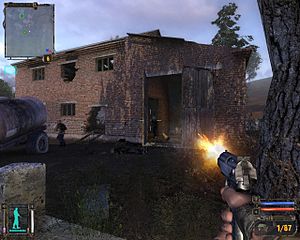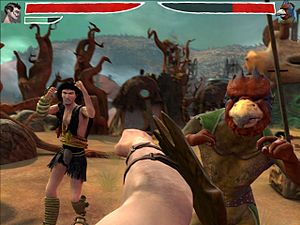First-person (video games) facts for kids
In video games, first-person means you see the game world through the eyes of your character. It's like looking through their eyes! This view is also used when you're driving a car or flying a plane in a game, seeing from the cockpit or front seat.
The most popular type of first-person game today is the first-person shooter (FPS). In these games, seeing through your character's eyes is a super important part of how you play. Many other types of games also use this view. These include other shooter games like light gun shooters, rail shooters, and shooting gallery games. You'll also find it in adventure games, flight simulations, racing games, role-playing video games, and vehicle simulations.
Contents
How First-Person Games Work
In first-person games, you usually see what your character, called an avatar, would see. This means you often can't see your character's whole body. But you might see their hands or the weapons they are holding.
This view is also great for games where you control a vehicle. Think of flight simulators or racing games where you see from the driver's seat. Many first-person games also use special sound effects. The volume of sounds changes depending on where they are around your character.
First-person games don't need fancy animations for your character's body. They also don't need complex camera controls like games where you see your character from behind. A first-person view makes it easier to aim, because your character's body isn't blocking your view. However, it can be tricky to jump between platforms. It's harder to guess the right timing and distance without seeing your character's body. Some players might also feel motion sickness when playing these games.
Players expect objects in first-person games to look the right size. But important items, like dropped objects or levers, might be made a bit bigger. This helps you see them more easily.
History of First-Person Games
Early Days of First-Person Games
First-person views have been used in many different game types. This includes several kinds of shooter games. Shooting gallery games, which came from old carnival games, often use a first-person view. In these games, you aim at moving targets on a screen. These games then led to rail shooters. Rail shooters also use a first-person view, but they move you along a set path through the game. If these games use light guns, they are called light gun shooters. Today, the most popular first-person game is the first-person shooter (FPS). These games let you move freely in a 3D world.
First-person views in racing games go way back to the late 1960s. Games like Kasco's Indy 500 (1968) and Chicago Coin's Speedway (1969) used this view. In video games, first-person driving started with Nürburgring 1 and Atari's Night Driver in 1976.
It's not totally clear which was the very first FPS video game. Two games claim this title: Spasim and Maze War. It's hard to know for sure because the exact dates for Maze Wars creation are not clear. But Spasims development is much better recorded.
Maze War was likely first made in the summer of 1973. It let one player explore a maze. Later, in 1973 and 1974, players could shoot each other in multiplayer mode. Spasim was created in the spring of 1974. It was a simple space flight simulation game with a first-person 3D view. You could play it online with others using the PLATO network.
Other early first-person games include Futurewar (1976) and the tank game Panther (1975). In 1979, two important first-person space combat games came out: Star Fire and Star Raiders. Star Raiders was very popular and influenced later games like Wing Commander and X-Wing.
First-Person Games in the 1980s
In the early 1980s, more first-person shooter games appeared. These included Taito's Space Seeker (1981) and Sega's 3D arcade game SubRoc-3D (1982).
Flight simulators became a popular type of first-person game for home computers. FS1 Flight Simulator (1979) and Flight Simulator II (1983) were big hits. MicroProse made many first-person air combat games, like F-15 Strike Eagle (1985).
Many maze games with a first-person view came out, like 3D Monster Maze (1981). Then came Wayout (1982), which had smooth movement using a special graphics method called raycasting. This made the game look very fluid, like later games MIDI Maze and Wolfenstein 3D. In 1983, Capture the Flag allowed two players to play at once on a split screen.
When the Atari ST and Amiga computers came out in 1985, games got better graphics. In 1987, MIDI Maze was released. It used raycasting to draw square corridors quickly. It also had a networked multiplayer mode where players could battle each other. This was an early form of deathmatch.
In 1987, Taito's Operation Wolf arcade game started a trend for realistic military action shooters. It had great graphics for its time. Later, Operation Thunderbolt (1988) added a pseudo-3D view. Sega's Line of Fire (1989) made things even more realistic by letting you turn corners.
Golgo 13: Top Secret Episode (1988) had first-person shooter parts, including a sniper rifle you could use to shoot enemies from far away. Star Cruiser (1988) was another important game.
In the late 1980s, first-person driving games like Test Drive (1987) and Vette! (1989) became popular. Hard Drivin' (1989) was very important. It had fast, filled-polygon graphics and realistic car physics. It even had instant replays after crashes!
First-Person Games in the 1990s
In 1990, SNK released fighting games with a first-person view, like Crossed Swords. In late 1991, id Software released Catacomb 3D. This game showed the player's hand on the screen. This made it feel even more like you were seeing through the character's eyes.
Taito's Gun Buster came out in arcades in 1992. It let players move on foot and aim with a special light gun. It also had a two-player co-op mode and a deathmatch mode for competitive play.
In 1992, Ultima Underworld: The Stygian Abyss was one of the first games to use textured environments and 3D objects. This technology was later used in System Shock. Also in 1992, id Software improved their technology for Wolfenstein 3D. This game became very popular and set many standards for the genre. For example, you could collect different weapons and switch between them using number keys.
Doom (1993) took Wolfenstein 3Ds ideas and made them even better. It had higher resolution, better textures, and different heights like stairs. Its levels were more complex and could have sloped walls, unlike Wolfenstein 3Ds grid. Doom also had basic lighting effects, making the 3D world feel more real. Doom allowed competitive matches between multiple players, which became known as deathmatches. Doom is often seen as the most important first-person shooter ever made.
The 1995 game Descent used a full 3D graphics engine for its enemies. This was different from earlier games that used flat images. It also let the player move in all six directions (up/down, left/right, forward/backward, and rotating).
See also
 In Spanish: Primera persona (videojuegos) para niños
In Spanish: Primera persona (videojuegos) para niños
- 3D graphics
- First-person shooter engine
- Simulator sickness
- Virtual reality



